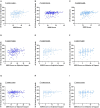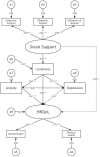Loneliness as a mediation from social support leading to a decrease of health-related quality of life among PLWHIV
- PMID: 36684920
- PMCID: PMC9846772
- DOI: 10.3389/fpubh.2022.1067870
Loneliness as a mediation from social support leading to a decrease of health-related quality of life among PLWHIV
Abstract
This study focused on the mental health of people living with HIV(PLWHIV) and explored their relationship between loneliness and perceived social support, health related quality of life (HRQoL) with a method of structural equation model. We collected clinical and psychological data from consecutively enrolled PLWHIV. A total of 201 PLWHIVs were enrolled and measured with self-reporting survey instruments of UCLA Loneliness Scale, Self-Rating Depression Scale, Self-Rating Anxiety Scale, Social Support Ratio Scale and Short Form Health Survey-36. The levels of loneliness, depression, anxiety, perceived social support and HRQoL were assessed. PLWHIV enrolled were divided into two groups of loneliness and non-loneliness based on their UCLA Loneliness Scale scores. Multivariable analysis indicated that being married is a protective factor associated with loneliness (OR = 0.226; P = 0.032). We further found the loneliness group had a higher level of depression (P < 0.001) and anxiety (P < 0.001), but lower level of HRQoL (P < 0.001) than the non-loneliness group. We found there was a positive linear correlation between social support and HRQoL among the enrolled PLWHIVs (r2 = 0.0592; P = 0.0005). A structural equation model (SEM) was established to evaluate whether the loneliness played as a mediation role between social support and HRQoL. The model showed loneliness as a mediation from social support leading to a decrease of HRQoL. Our findings showed a potential psychological pathway from social support to HRQoL, suggesting the need for interventions focusing on social support may improve poor HRQoL lead by loneliness.
Keywords: health related quality of life; loneliness; mediation; mental health; people living with HIV; social support.
Copyright © 2023 Qian, Li, Liao, Liao, Chen, Han, Yu, Xu, Peng and Cai.
Conflict of interest statement
The authors declare that the research was conducted in the absence of any commercial or financial relationships that could be construed as a potential conflict of interest.
Figures




Similar articles
-
Depression and anxiety mediate perceived social support to predict health-related quality of life in pregnant women living with HIV.AIDS Care. 2018 Sep;30(9):1147-1155. doi: 10.1080/09540121.2018.1456640. Epub 2018 Apr 1. AIDS Care. 2018. PMID: 29607666
-
The relationship of social support, mental health, and health-related quality of life in human immunodeficiency virus-positive men who have sex with men: From the analysis of canonical correlation and structural equation model: A cross-sectional study.Medicine (Baltimore). 2018 Jul;97(30):e11652. doi: 10.1097/MD.0000000000011652. Medicine (Baltimore). 2018. PMID: 30045316 Free PMC article.
-
A Cross-Sectional Analysis of Psychosocial Mediators Between Discrimination and Health-Related Quality of Life Among Sexual and Gender Minority Cancer Survivors.Psychooncology. 2025 Apr;34(4):e70154. doi: 10.1002/pon.70154. Psychooncology. 2025. PMID: 40246588
-
Associations between loneliness and perceived social support and outcomes of mental health problems: a systematic review.BMC Psychiatry. 2018 May 29;18(1):156. doi: 10.1186/s12888-018-1736-5. BMC Psychiatry. 2018. PMID: 29843662 Free PMC article.
-
Loneliness in psychosis: a systematic review.Soc Psychiatry Psychiatr Epidemiol. 2018 Mar;53(3):221-238. doi: 10.1007/s00127-018-1482-5. Epub 2018 Jan 11. Soc Psychiatry Psychiatr Epidemiol. 2018. PMID: 29327166
Cited by
-
Perceived Social Support and Health-Related Quality of Life Among Hypertensive Patients: A Latent Profile Analysis and the Role of Delay Discounting and Living Alone.Risk Manag Healthc Policy. 2024 Sep 4;17:2125-2139. doi: 10.2147/RMHP.S476633. eCollection 2024. Risk Manag Healthc Policy. 2024. PMID: 39246592 Free PMC article.
-
Social networks and the mental health among Chinese older adults: the mediating role of loneliness and moderating role of Internet use.Front Public Health. 2023 Oct 3;11:1242356. doi: 10.3389/fpubh.2023.1242356. eCollection 2023. Front Public Health. 2023. PMID: 37854246 Free PMC article.
-
The mediating role of loneliness between psychological resilience and health-related quality of life among patients with nasopharyngeal carcinoma: a cross-sectional study using structural equation modeling.BMC Psychiatry. 2024 Oct 9;24(1):668. doi: 10.1186/s12888-024-06036-z. BMC Psychiatry. 2024. PMID: 39385186 Free PMC article.
-
Magnitude of Depression and Associated Factors in Women Living With HIV in Northwest, Ethiopia: Mediation Analysis.AIDS Res Treat. 2025 Jan 9;2025:9578192. doi: 10.1155/arat/9578192. eCollection 2025. AIDS Res Treat. 2025. PMID: 39831266 Free PMC article.
References
-
- Patel P, Rose CE, Collins PY, Nuche-Berenguer B, Sahasrabuddhe VV, Peprah E, et al. . Noncommunicable diseases among HIV-infected persons in low-income and middle-income countries: a systematic review and meta-analysis. Aids. (2018) 32(Suppl. 1): S−20. 10.1097/QAD.0000000000001888 - DOI - PMC - PubMed
Publication types
MeSH terms
LinkOut - more resources
Full Text Sources
Medical

